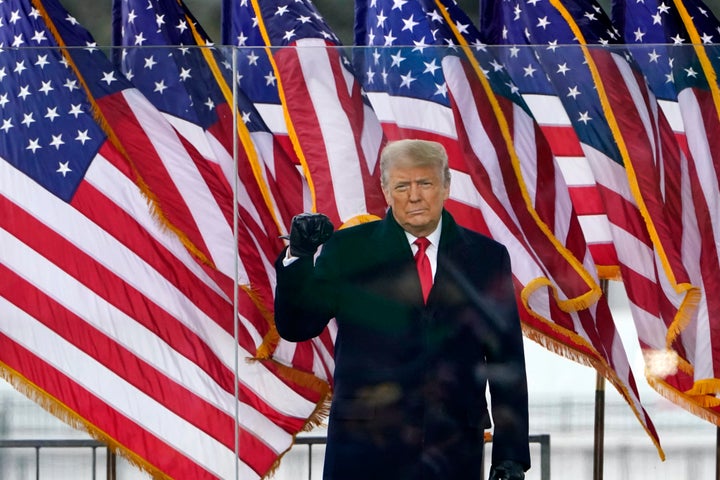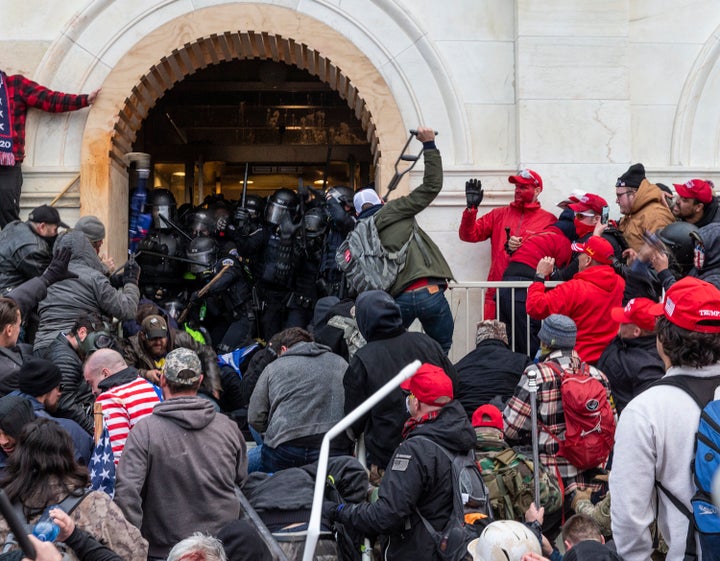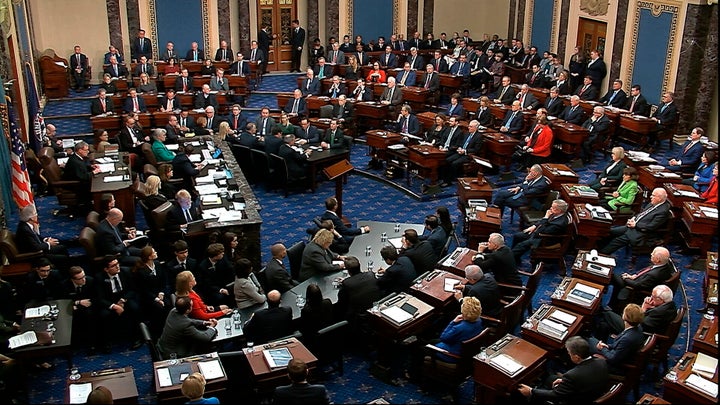Three US presidents have been impeached by the House. President Donald Trump is about to be the first to be impeached twice ― and for the most serious impeachment charge in history: inciting an insurrection that left five dead as part of a plot to keep him in power by forcing Congress to overturn the results of an election he lost.
The House of Representatives plans to vote to impeach Trump on Wednesday. It’s unclear what will happen next and whether the (soon-to-be-formerly) Republican-controlled Senate will launch a trial within the final days of Trump’s term.
But it isn’t just about Trump’s time in office, proponents of impeachment argue. If Trump doesn’t face consequences, any future president would know they could encourage a violent insurrection and get away with it. A future president could push to remain in power by throwing out votes for their opponent. And unless he’s banned from running again, that future president could be Trump.
Trump’s actions make him “an imminent threat,” perpetrating an “ongoing assault on our democracy” that demands an “immediate need for action,” Speaker Nancy Pelosi wrote in a letter to the House Democratic Caucus.
“We cannot allow this unprecedented provocation to go unanswered,” Democratic representatives Jamie Raskin, David Cicilline and Ted Lieu said in a statement Monday. “Everyone involved in this assault must be held accountable, beginning with the man most responsible for it — President Donald Trump.”
“[W]e have seen presidents abuse their power, but we had never witnessed an American president incite a violent mob on the citadel of our democracy in a desperate attempt to cling to power,” Cicilline wrote in The New York Times.
The Democratic majority on the House Judiciary Committee released a 76-page impeachment report on Tuesday evening detailing Trump’s culpability in inciting the insurrection. The report calls the president an “imminent threat” to the nation.
“President Trump poses an imminent threat to the safety and security of the United States,” the report says. “His continued presence in office is a clear and present danger to the United States. He has interfered with the peaceful transition of power and his actions show that he will continue to do so unless removed.”
The report provides plenty of evidence that Trump incited the crowd that stormed the Capitol: tweets, public statements and a speech directly to them just before the insurrection. It also provides evidence that the insurrectionists responded to Trump’s statements. And there is little question among constitutional scholars that inciting an insurrection as part of a plot to steal an election is grounds for impeachment.
“It is just what Hamilton asked for,” Philip Bobbitt, the co-author of “Impeachment: A Handbook,” said.
Inciting An Insurrection

Trump’s second impeachment is intimately connected to his first one. To recap, in 2019, Trump attempted to blackmail the president of Ukraine into fabricating a corruption investigation into former vice president Joe Biden, whom Trump feared would be his most formidable presidential opponent, by withholding congressionally approved military aid. A whistleblower disclosed this illegal scheme to Congress and Trump was impeached, but not removed from office.
After Biden won the Democratic Party nomination, Trump began to lay the groundwork for contesting the election by falsely claiming that rules implemented by states to make it safer for people to vote absentee during the coronavirus pandemic were not allowed and would promote fraud via mail-in ballots. After he lost the election, he used the false narrative that he invented to claim that the election was rigged and should be overturned. He then pressured and threatened Republican state officials to steal the election for him including pressuring Georgia Secretary of State Brad Raffensperger, a Republican who backed Trump, to “find” enough votes to overcome Biden’s margin in the state or else he would face manufactured criminal charges.
When these GOP officials declined to help Trump steal the election, he pivoted to pressuring Republicans in Congress and vice president Mike Pence to refuse to certify Biden’s electors in five states during a joint session of Congress held on January 6.
As part of this pressure campaign, Trump called his supporters to Washington for a rally on January 6 that he promised, “will be wild!” A crowd of Trump supporters gathered on the National Mall where Trump repeated his lie that he won the election and called on them to march on the Capitol. Those supporters included neo-Nazis, CEOs, Oath Keepers, an Olympic gold medalist, Proud Boys, doctors, stay-at-home dads, police officers and believers in the QAnon conspiracy theory that says Trump is a demigod and Democrats are part of a secret cabal of paedophiles that harvest children for their adrenal glands.
“[Y]ou’ll never take back your country with weakness,” Trump said. “You have to show strength and be strong.”
He added that “if you don’t fight like hell, you’re not going to have a country anymore,” while telling the crowd to give “the weak” Republicans the “kind of pride and boldness they need to take back our country.”
“These comments directly incited a violent attack on the Capitol that threatened the safety and lives of the vice president, the speaker of the house, and the president pro tempore of the Senate, the first three individuals in the line of succession to the presidency,” the impeachment report states.
The mob followed the orders of their commander in chief and proceeded to sack the Capitol. They killed a Capitol police officer. Four others died, including one woman shot by an officer. Pipe bombs were found at both the Democratic and Republican party headquarters. They wrote “Murder the media,” and chanted, “Hang Mike Pence!” as they rampaged through the building. They destroyed a commemorative display for representative John Lewis, the late civil rights hero. They brought flex cuffs, semiautomatic long guns, pistols, Molotov cocktails, homemade napalm, blunt objects, pepper spray and fire extinguishers. They erected a gallows.
“We wait and take orders from our president,” one insurrectionist said.
As mayhem unfolded, Trump reportedly watched it on television with glee as the insurrection he created would delay and possibly derail the certification of the election. He rebuffed calls to deploy the National Guard to quell the insurrection. And then he praised the insurrectionists he inspired as he lightly urged them to go home.
“These are the things and events that happen when a sacred landslide election victory is so unceremoniously and viciously stripped away from great patriots who have been badly and unfairly treated for so long,” Trump tweeted. “Go home with love and in peace. Remember this day forever.”
In a subsequent video, Trump said the insurrectionists are “very special people,” and told them, “we love you.”
“He must be removed from office as swiftly as the Constitution allows,” the House impeachment report states. “He must also be disqualified to prevent the recurrence of the extraordinary threat he presents.”
Congress eventually reconvened to certify the election for Biden, despite Trump’s best efforts to stop them. Still, 147 Republicans voted to overturn the election despite the presentation of no evidence of widespread fraud or misconduct.
The House Will Impeach

The House will now impeach Trump for this incitement to insurrection, which began as a plot to steal the November election he lost.
“President Trump gravely endangered the security of the United States and its institutions of government,” according to the articles of impeachment. “He threatened the integrity of the democratic system, interfered with the peaceful transition of power, and imperilled a coequal branch of Government. He thereby betrayed his trust as President, to the manifest injury of the people of the United States.”
House Democrats confirmed that they have the votes to impeach, and multiple reports indicate that between 10 and 20 Republicans may join them. Five Democrats voted to impeach President Bill Clinton, the current record for votes to impeach a president of the same party. (This would be different had President Richard Nixon not resigned and faced impeachment.)
Republican representatives Liz Cheney, John Katko and Adam Kinzinger announced their support for impeachment Tuesday evening. No House Republicans voted to impeach Trump the first time.
“The President of the United States summoned this mob, assembled the mob, and lit the flame of this attack,” Cheney, the No. 3 member of GOP House leadership, said in a statement. “Everything that followed was his doing. None of this would have happened without the President.”
The vote will occur on Wednesday after the House passes a resolution on Tuesday introduced by Raskin calling on Pence to invoke the 25th amendment, which would remove Trump from wielding power for the remainder of his term in office.
“This is not just a crisis and an emergency,” Raskin told the House Rules Committee during a hearing on his bill on Tuesday. “It is a continuing crisis and emergency. It is not over yet. Can we say that we feel safe being in the hands of this president, with the horror and the threats returning to the Nation’s capital?”
If Pence does not invoke the 25th Amendment in the next 24 hours, Pelosi said, the House will vote on and pass articles of impeachment on Wednesday. House Democrats feel an urgent need to respond and put their foot down on what is acceptable behaviour by the president, for both the present and future history, no matter whether Trump can be removed or not.
“Whether impeachment can pass the United States Senate is not the issue,” House Majority Leader Steny Hoyer (D-Md.) told reporters Monday.
Will The Senate Convict?

It remains to be seen is when, or if, the Senate holds a trial to convict the president and whether 17 Republicans vote to remove Trump from office or, if he is no longer in office, bar him from holding office ever again.
House Democratic leadership provided conflicting statements about whether or not they would deliver the impeachment to the Senate immediately after passing it or wait until Biden has been given enough time to enact his agenda.
“Let’s give President-elect Biden the 100 days he needs to get his agenda off and running, and maybe we will send the articles some time after that,” House majority whip James Clyburn said on Monday.
Hoyer, however, stated his preference to send the articles of impeachment to the Senate immediately in an interview later on Monday. That is also the position of Cicilline and many others.
Senate majority leader Mitch McConnell previously recessed the Senate until Jan. 19 and stated no plans to bring the Senate back before Biden takes office.
But senator Chuck Schumer, the Democratic leader, is looking at invoking a post-9/11 agreement between the Senate majority and minority under which he and McConnell would together call the Senate back into session due to “intervening circumstances.”
President-elect Biden is open to the Senate pursuing a trial after he takes office. He is asking lawmakers to look into whether the Senate can “bifurcate” its daily operations to spend, “a half-day dealing with impeachment and a half-day,” confirming his appointees and passing Covid-19 relief legislation.
It is not immediately clear whether there are enough Republicans to ultimately convict Trump in any Senate trial. At present, Republican senators. Pat Toomey and Lisa Murkowski are the only two new Republicans who have suggested they support removing Trump from office through impeachment. Senator Mitt Romney, who previously voted to convict and remove Trump during his first impeachment in 2020, has suggested he would do so again.
“When the president incites an attack against Congress, there must be a meaningful consequence,” Romney said in a statement on Monday.
Romney remains the only senator to vote to convict a president of his or her own party in American history.
Late on Tuesday, The New York Times reported that McConnell was “pleased” with the prospect of impeachment.
There is also the question about whether or not Congress can even impeach an ex-president. This is an unsettled legal question that constitutional scholars disagree on.
Since the Constitution provides for the impeachment of civil officers, the question arises as to whether an ex-president, or other ex-official, can be impeached or convicted once they are no longer a civil officer.
“The constitution is very clear on the point,” Bobbitt said. “You have to be an officer of the United States to be impeached.”
University of North Carolina School of Law professor Michael Gerhardt, the author of “Impeachment: What You Need To Know,” however, argues in Just Security that “presidents and the other officials who are subject to impeachment are not like the rest of us. Once they leave office and return to their private lives, they are still ex-presidents and former officials who may have committed impeachable offences in office.”
A panel of six legal scholars asked by The Washington Post about this question in 2019 also came to a split decision.
There are, however, three precedents of federal officials facing impeachment after leaving office, according to the National Constitution Center. The Senate either considered impeachment, as in the case of ex-senator William Blount, or voted on articles of impeachment in the cases of former Secretary of War William Belknap and federal judge West Hughes Humphries. The Senate voted against convicting Belknap, who had resigned prior to the Senate holding a trial, but voted to convict Humphries and ban him from future office after he left his position to join the Confederacy.
Republicans who supported overturning the election and some others oppose impeachment with claims that it will be “divisive,” and prevent the country from “healing.” But Trump won’t let them off so easy.
As is often the case with Trump, he made these pleas for appeasement look even more absurd as he issued new threats to Congress, this time for pursuing impeachment.
“For Nancy Pelosi and Chuck Schumer to continue on this path, I think it’s causing tremendous danger to our county and it’s causing tremendous anger,” Trump said on Tuesday. Unlike his previous threats, he added a disclaimer this time: “I want no violence.”
Further insurrectionist activities are being planned by Trump supporters up through the Jan. 20 inauguration, including the assassination of members of Congress.

